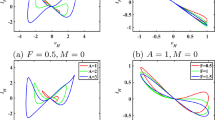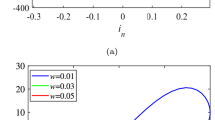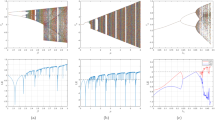Abstract
Chaos-based true random bit generators have been demonstrated in many studies to be feasible and secure for crypto-system applications. In this work, we demonstrate that an FPGA-based non-autonomous chaotic oscillator, used as a true random number generator, can be compromised via cryptanalysis attacks. First, we realize non-autonomous chaotic oscillator (previously implemented only in analog form) on a modular FPGA platform. The oscillator architecture is simplified to eliminate the Sin function and is described in details in VHDL. Then, we propose chaotic oscillator attacking system including clock glitch generator to compromise the oscillator by injecting glitches on function clock. The parameters and positions of those glitches are carefully determined to achieve a successful attack. The experimental results show that the system is attacked, and the generated glitched bit-streams are distorted, unlike the bit-streams generated without glitching. The randomness of the generated bit-streams is checked using the NIST test tool.















Similar content being viewed by others
References
Saleh, S.: A secure data communication system using cryptography and steganography. Int. J. Comput. Netw. Commun. (IJCNC) 5(3), 125–137 (2013)
Sunar, B.: True random number generators for cryptography. In: Koç, Ç.K. (ed.) Cryptographic Engineering. Springer, Boston, MA (2009)
Filali, R.L., Benrejeb, M., Borne, P.: Observer-based secure communication design using discrete-time hyperchaotic systems. Commun. Nonlinear Sci. Numer. Simul. 19(5), 1424–1432 (2014)
Ergun, S., O zoguz, S.: Truly random number generators based on a non-autonomous chaotic oscillator. Int. J. Electron. Commun. 61, 235–242 (2007)
Ren, G., Zhou, P., Ma, J., Cai, N., Alsaedi, A., Ahmad, B.: Dynamical response of electrical activities in digital neuron circuit driven by autapse. Int. J. Bifurc. Chaos 27(12), 1750187 (2017)
Bonny, T., Aldebsi, R., Majzoub, S., Elwakil, A.S.: Hardware optimized FPGA implementations of high speed true random bit generators based on switching-type chaotic oscillators. J. Circuits Syst. Signal Process. 38, 1342 (2019)
Ma, J., Zhou, P., Ahmad, B., Ren, G., Wang, C.: Chaos and multi-scroll attractors in RCL-shunted junction coupled Jerk circuit connected by memristor. PLoS ONE 13(1), e0191120 (2018)
Dong, E.Z., Yuan, M.F., Zhang, C., Tong, J.G., Chen, Z.Q., Du, S.Z.: Topological horseshoe analysis, ultimate boundary estimations of a new 4D hyperchaotic system and its FPGA implementation. Int. J. Bifurc. Chaos 28(07), 1850081 (2018)
Bonny, T., Henkel, J.: LICT: left-uncompressed instructions compression technique to improve the decoding performance of VLIW processors. In: Design Automation Conference (DAC09), pp. 903–906, USA (2009)
Bonny, T., Affan Zidan, M., Salama, K.N.: An adaptive hybrid multiprocessor technique for bioinformatics sequence alignment. In: International Conference on Biomedical Engineering Conference (2010)
Bonny, T., Henno, S.: Image edge detectors under different noise levels with FPGA implementations. J. Circuits Syst. Comput. 27(13), 1850209 (2018)
Bonny, T., Rabie, T., Abdul Hafez, A.H.: Multiple histogram-based face recognition with high-speed FPGA implementation. J. Multimed. Tools Appl. 77(18), 24269–24288 (2018)
Trejo-Guerra, R., Tlelo-Cuautle, E., Carbajal-Gomez, V.H., Rodriguez-Gomez, G.: A survey on the integrated design of chaotic oscillators. Appl. Math. Comput. 219(10), 5113–5122 (2013)
Koyuncu, I., Ozcerit, A.T., Pehlivan, I.: Implementation of FPGA-based real time novel chaotic oscillator. Nonlinear Dyn. 77(1–2), 49–59 (2014)
Chen, C., Chen, H., Ma, H., Meng, Y., Ding, Q.: FPGA implementation of a UPT chaotic signal generator for image encryption. Pac. Sci. Rev. A Nat. Sci. Eng. 17(3), 97–102 (2015)
De Micco, L., Larrondo, H.A.: Methodology for FPGA implementation of a chaos-based AWGN generator. In: Gazzano, J.D.D. (ed.) Field-Programmable Gate Array (FPGA) Technologies for High Performance Instrumentation. IGI Global, Hershey (2016)
Qiu, M., Yu, S., Wen, Y., et al.: Design and FPGA implementation of a universal chaotic signal generator based on the Verilog HDL fixed-point algorithm and state machine control. Int. J. Bifurc. Chaos 27(3), 1750040–1750055 (2017)
Bonny, T., Elwakil, A.S.: FPGA realizations of high speed switching-type chaotic oscillators using compact VHDL codes. J. Nonlinear Dyn. 93(2), 819–833 (2018)
Tlelo-Cuautle, E., Quintas-Valles, A., de la Fraga, L., et al.: VHDL descriptions for the FPGA implementation of PWL-function-based multi-scroll chaotic oscillators. PLoS ONE 11(12), e0168300 (2016)
SPROTT, J.C.: Chaos and Time–Series Analysis, p. 507. Oxford University Press, Oxford (2003). ISBN 01-985-0840-9
Kowalski, J.M., Albert, G.L., Gross, G.W.: Asymptotically synchronous chaotic orbits in systems of excitable elements. Phys. Rev. A 15 42(10), 6260–6263 (1990)
Kennedy, M.P.: Robust OP AMP realization of Chua’s circuit. Frequenz 46, 66–80 (1992)
Kennedy, M.P.: Chaos in the Colpitts oscillator. IEEE Trans. Circuits Syst. I Fundam. Theory Appl. 41, 771–774 (1994)
Sivaganesh, G.: Analytical study of an MLC circuit with quasiperiodic forcing. Chin. J. Phys. 52(6), 1760–1769 (2014)
Dong, E.Z., Liang, Z.H., Du, S.Z., Chen, Z.Q.: Topological horseshoe analysis on a four-wing chaotic attractor and its FPGA implementation. Nonlinear Dyn. 83(1–2), 623–630 (2016)
Giancane, L.: Side-channel attacks and countermeasures. In: The Design Of Secure Ic’s Devices For Cryptographic Applications. University of Roma (2011)
Endo, S., Sugawara, T., Homma, N., Aoki, T., Satoh, A.: An on-chip glitchy-clock generator for testing fault injection attacks. J. Cryptogr. Eng. 1, 265 (2011)
Ma, Jun, Fuqiang, Wu, Alsaedi, Ahmed, Tang, Jun: Crack synchronization of chaotic circuits under field coupling. Nonlinear Dyn. 93(4), 2057–2069 (2018)
Masoumeh, D.: Analysis and design of clock-glitch fault injection within an FPGA. Master’s thesis, University of Waterloo, Canada (2013)
Balasch, J., Gierlichs, B., Verbauwhede, I.: An in-depth and black-box characterization of the effects of clock glitches on 8-bit MCUs. In: 2011 Workshop on Fault Diagnosis and Tolerance in Cryptography (2011)
Luo, P., Fei, Y.: Faulty clock detection for crypto circuits against differential fault analysis attack. IACR Cryptol ePrint Arch. 967, 1–8 (2014)
Qiao, Y., Lu, Z., Liu, H., Liu, Z.: Clock glitch fault injection attacks on an fpga AES implementation. J. Electrotechnol. Electr. Eng. Manag. 1(1), 23–27 (2017)
Canivet, G., Maistri, P., Leveugle, R., et al.: Glitch and laser fault attacks onto a secure AES implementation on a SRAM—based FPGA. J. Cryptol. 24, 247 (2011)
Santosh, D.: High speed clock glitching. Master’s thesis, Cleveland State University (2015)
Allagui, A., Rojas, A.E., Bonny, T., Elwakil, A.S., Abdelkareem, M.A.: Nonlinear time-series analysis of current signal in cathodic contact glow discharge electrolysis. J. Appl. Phys. 119, 203303 (2016)
Elwakil, A.S., Ozoguz, S.: Chaos in a pulse-excited resonator with self feedback. Electron. Lett. 39, 831–833 (2003)
Butcher, J.C.: Numerical Methods for Ordinary Differential Equations, 2nd edn. Wiley, New York (2008)
Dieci, L.: Jacobian free computation of Lyapunov exponents. J. Dyn. Differ. Equ. 14(3), 697–717 (2002)
Digilent Inc. www.zedboard.org (2016)
Inc, X.: 7 Series FPGAs Overview, vol. 1. Xilinx, San Jose (2014)
Xilinx, Vivado design suite—hlx editions (2016)
http://csrc.nist.gov/groups/ST/toolkit/rng/documentation_software.html
Author information
Authors and Affiliations
Corresponding author
Ethics declarations
Conflict of interest
The authors declare that they have no conflict of interest.
Additional information
Publisher's Note
Springer Nature remains neutral with regard to jurisdictional claims in published maps and institutional affiliations.
Rights and permissions
About this article
Cite this article
Bonny, T., Nasir, Q. Clock glitch fault injection attack on an FPGA-based non-autonomous chaotic oscillator. Nonlinear Dyn 96, 2087–2101 (2019). https://doi.org/10.1007/s11071-019-04907-9
Received:
Accepted:
Published:
Issue Date:
DOI: https://doi.org/10.1007/s11071-019-04907-9




